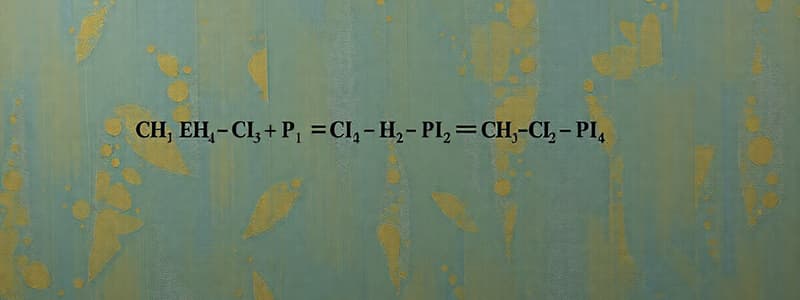Podcast
Questions and Answers
What does the symbol (aq) represent in a chemical equation?
What does the symbol (aq) represent in a chemical equation?
- Aqueous, meaning dissolved in water (correct)
- Acidic, indicating the presence of an acid
- Atmospheric, indicating gas in the air
- Alkaline, indicating a base solution
What is the first step in writing a chemical equation?
What is the first step in writing a chemical equation?
- Creating a word equation (correct)
- Writing the balanced equation
- Formulating the skeleton equation
- Identifying reactants and products
Which of the following represents a skeleton equation?
Which of the following represents a skeleton equation?
- H2O is produced from H2 and O2
- H2 + O2 → H2O (correct)
- Water is formed by hydrogen and oxygen
- 2H2 + O2 → 2H2O
What is the importance of balancing chemical equations?
What is the importance of balancing chemical equations?
In the example of propane combustion, how many water molecules are produced?
In the example of propane combustion, how many water molecules are produced?
How many oxygen molecules are needed for the complete combustion of one propane molecule?
How many oxygen molecules are needed for the complete combustion of one propane molecule?
What does balancing a chemical equation ensure?
What does balancing a chemical equation ensure?
Which element had to be balanced first in the propane combustion example?
Which element had to be balanced first in the propane combustion example?
What must be adjusted to balance the oxygen in the propane combustion reaction?
What must be adjusted to balance the oxygen in the propane combustion reaction?
In a balanced chemical equation, what must remain equal on both sides?
In a balanced chemical equation, what must remain equal on both sides?
What are the substances called that undergo change during a chemical reaction?
What are the substances called that undergo change during a chemical reaction?
What does the arrow (→) in a chemical equation indicate?
What does the arrow (→) in a chemical equation indicate?
In the equation 2H₂ + O₂ → 2H₂O, what does the coefficient '2' in front of H₂ and H₂O represent?
In the equation 2H₂ + O₂ → 2H₂O, what does the coefficient '2' in front of H₂ and H₂O represent?
What law dictates that the mass of reactants must equal the mass of products in a chemical reaction?
What law dictates that the mass of reactants must equal the mass of products in a chemical reaction?
What are small numbers written at the lower right of a chemical symbol called?
What are small numbers written at the lower right of a chemical symbol called?
Which of the following statements about chemical equations is FALSE?
Which of the following statements about chemical equations is FALSE?
In reversible reactions, how is the arrow represented in the chemical equation?
In reversible reactions, how is the arrow represented in the chemical equation?
What do the physical states in chemical equations help to indicate?
What do the physical states in chemical equations help to indicate?
What does the subscript '2' in H₂O indicate?
What does the subscript '2' in H₂O indicate?
Which of the following is NOT a component of a chemical equation?
Which of the following is NOT a component of a chemical equation?
Flashcards are hidden until you start studying
Study Notes
Chemical Equations
- Definition: Symbolic representations of chemical reactions where reactants transform into products.
- Law of Conservation of Mass: States that matter can't be created or destroyed in a reaction, meaning the mass of reactants equals the mass of products.
- Reactants: Substances at the start of a reaction that undergo change.
- Products: New substances formed as a result of a reaction.
- Arrow (→): Separates reactants from products, indicating reaction direction.
- Coefficients: Numbers in front of chemical formulas indicating the number of molecules or moles of each substance.
- Subscripts: Small numbers at the lower right of a chemical symbol, indicating the number of atoms of each element in a molecule.
- States of Matter: Indicate the physical state of reactants and products:
- (s) solid
- (l) liquid
- (g) gas
- (aq) aqueous (dissolved in water)
Writing Chemical Equations
- Word Equations: Describe the reaction in words, helping to identify reactants and products.
- Skeleton Equations: Use chemical formulas instead of words, but are not yet balanced.
- Balancing Chemical Equations: Adds coefficients to chemical formulas to ensure equal numbers of each element on both sides of the equation, upholding the law of conservation of mass.
Balancing Example: Combustion of Propane
- Reaction: Propane (C₃H₈) burns with oxygen (O₂) to produce carbon dioxide (CO₂) and water (H₂O).
- Skeleton Equation: C₃H₈ + O₂ → CO₂ + H₂O
- Balancing Steps:
- Count atoms of each element on both sides of the equation.
- Balance carbon atoms by adding a coefficient of 3 in front of CO₂.
- Balance hydrogen atoms by adding a coefficient of 4 in front of H₂O.
- Balance oxygen atoms by adjusting the coefficient of O₂ to 5.
- Balanced Equation: C₃H₈ + 5O₂ → 3CO₂ + 4H₂O
Studying That Suits You
Use AI to generate personalized quizzes and flashcards to suit your learning preferences.




